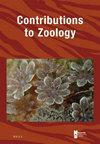多异种共生会促进同域分化吗?一种基于奥库帕Oxydromus okupa的形态计量学和系统地理学方法
IF 2.2
2区 生物学
Q1 ZOOLOGY
引用次数: 5
摘要
奥库帕多毛动物与双壳类Scrobicuria plana和Macomopsis pellucida共同生活在圣佩德罗潮间带(CI=Cádiz潮间带),靠近希皮奥纳港(CH),以及加的斯湾潮下带(CS=Cádiz潮下带)。我们从形态、生态学(包括虫害特征)和遗传学(潮间带种群、16S和ITS-1基因)方面分析了这些种群。我们认为“宿主”、“环境”以及“宿主与环境”的结合是种群间变异的可能因素。形态计量学显示,CI、CH和CS有三个明确的聚类,显示组间表型差异在35%至50%之间。寄主外壳长度在平坦S.plana的26至36毫米之间,透明M.pellucida的20至28毫米之间。幼年O.okupa对小透明藻的侵扰表明它们表现出积极的大小分离行为。潮间带似乎不太有利(侵扰率<25%,而潮下带的侵扰率高达65%),并且没有出现最近的瓶颈事件。总体而言,CI和CH在遗传上是同质的,但表现出显著的差异(每个宿主物种中都有一个显性单倍型),这表明宿主转移是基因流动的软屏障。与宿主进入有关的大多数特征在种群之间各不相同,这表明共生行为在减少泛混合生殖和导致同域共生种群物种形成过程的初始阶段中发挥着关键作用。因此,奥库帕的多雄性和共生行为似乎是导致其表型多样性、显著生态差异和遗传分化的潜在机制。本文章由计算机程序翻译,如有差异,请以英文原文为准。
Does polyxenous symbiosis promote sympatric divergence? A morphometric and phylogeographic approach based on Oxydromus okupa (Annelida, Polychaeta, Hesionidae)
The polychaete Oxydromus okupa lives in association with the bivalves Scrobicularia plana and Macomopsis pellucida in the intertidal of Río San Pedro (CI = Cádiz Intertidal) and adjacent to CHipiona (CH) harbour, and in the subtidal of the Bay of Cádiz (CS = Cádiz Subtidal). We analyse these populations morphometrically, ecologically (including infestation characteristics) and genetically (intertidal populations, 16S and ITS-1 genes). We consider “host”, “environment” and the combined “host and environment” as possible factors of interpopulation variability. Morphometry revealed three well-defined clusters for CI, CH and CS, showing intergroup phenotypic differences ranging from 35 to 50%. Hosts shell lengths ranged between 26 and 36 mm for S. plana and 20 and 28 mm for M. pellucida. The infestation of small M. pellucida by juvenile O. okupa suggests they show an active size segregation behaviour. The intertidal seems to be less favourable (infestation rate <25% vs. up to 65% in the subtidal), and did not show recent bottleneck events. Overall, CI and CH were genetically homogeneous, but showed a significant divergence (one dominant haplotype in each host species), suggesting host shift as being a soft barrier to gene flow. Most characters related with host-entering varied among populations, suggesting symbiotic behaviour to play a key role in reducing panmixia and leading to the initial phases of a speciation process in sympatric symbiotic populations. Polyxeny and symbiotic behaviour in O. okupa seem thus to be underlying mechanisms contributing to its great phenotypic variety, marked ecological differences, and genetic divergence.
求助全文
通过发布文献求助,成功后即可免费获取论文全文。
去求助
来源期刊

Contributions to Zoology
生物-动物学
CiteScore
4.00
自引率
4.50%
发文量
16
审稿时长
>12 weeks
期刊介绍:
Contributions to Zoology solicits high-quality papers in all systematics-related branches of comparative zoology (including paleozoology). Preference will be given to manuscripts dealing with conceptual issues and to integrative papers (e.g., ecology and biodiversity, morphology and phylogeny and character state evolution, phylogeny and historical biogeography, systematics and bioinformatics, bioinformatics and biodiversity, habitat disturbance and biogeography, etc.). Reviews and alpha-taxonomic contributions are considered for publication, but acceptance will depend on their high quality and exceptional nature.
 求助内容:
求助内容: 应助结果提醒方式:
应助结果提醒方式:


